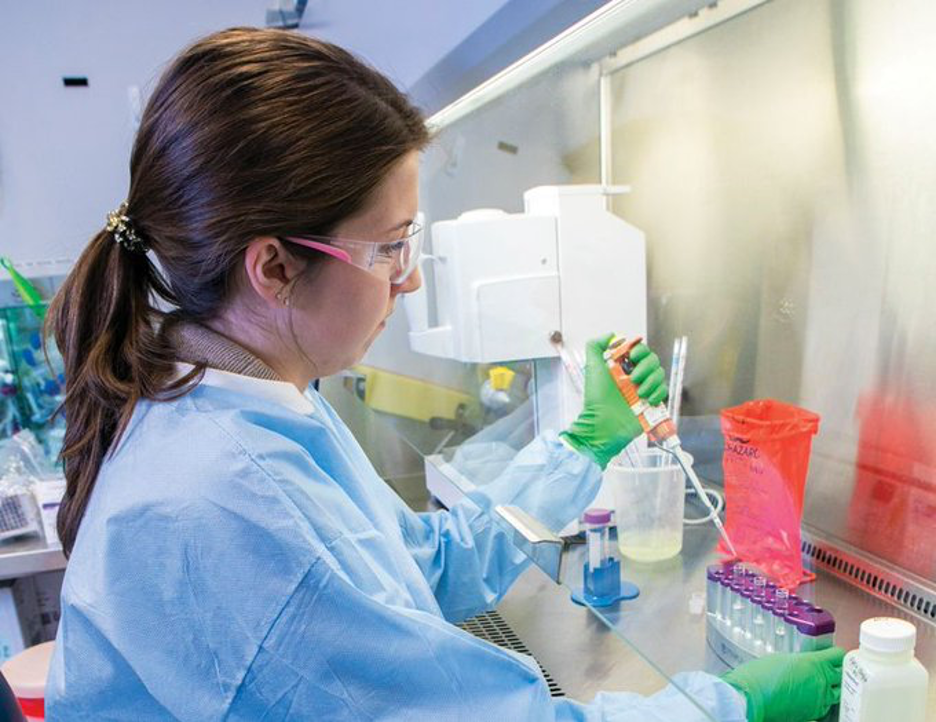TOWARDS A UNIVERSAL FLU VACCINE

A better understanding of the immune response to influenza is driving development of vaccines that protect against many strains of the virus.
Flu shots can be hard to sell to the public. Even a run-of-the-mill influenza infection can be debilitating to otherwise healthy people, and lethal to those who are elderly or frail, so vaccinations are important. The problem is that flu vaccines deliver inconsistent performance. “In a good season, we’re up to 60% effectiveness, but in bad, mismatched years it can be as low as 10% or 20%,” says Barney Graham, deputy director of the Vaccine Research Center at the US National Institute of Allergy and Infectious Diseases (NIAID) in Bethesda, Maryland.
Current flu vaccines provide protection only against the strains they have been matched to, so a ‘universal’ flu vaccine that provides broader protection against most influenza viruses has been a long-standing dream. The 2009 swine-flu pandemic, which caught the public-health community off guard and claimed the lives of as many as half-a-million people worldwide, gave the issue new urgency.
“The 2009 pandemic made it obvious and clear that we didn’t have good enough solutions for influenza vaccines,” says Graham. “We knew the virus, but we weren’t able to make enough vaccine quickly enough.” More-effective manufacturing is one solution but a single inoculation that protects against both seasonal and emerging strains would have much greater impact.
Fortunately, the timing of the pandemic coincided with great progress in the development of technologies for investigating the human response to influenza. “Around 2008 or 2009, people started finding a few broadly neutralizing antibodies against the influenza virus,” says Ian Wilson, a structural biologist specializing in vaccine development at Scripps Research Institute in La Jolla, California. “Once people started looking, many more were discovered.”
Now, around 100 years after the ‘Spanish flu’ pandemic of 1918 that killed about 50 million people, multiple universal-vaccine programmes are demonstrating promise in both preclinical and clinical testing. But it remains to be seen whether any will ultimately deliver the broad protection that clinicians seek.
A variable virus
Peter Palese, a microbiologist at the Icahn School of Medicine at Mount Sinai in New York City, believes that today’s flu vaccines come in for too much criticism. “They are fairly good vaccines but they’re not perfect,” he says. The main problem, he adds, is that they elicit a focused immune response against a moving target.
Humans are affected by two main types of influenza. Influenza A and B can both contribute to seasonal flu, but some influenza A subtypes preferentially infect animal hosts. Sometimes these subtypes abruptly acquire the ability to infect humans, leading to pandemics such as the one in 2009. Each year the seasonal flu vaccine is designed to cover two strains each of influenza A and B, based on the public-health community’s best informed guess about which strains will be dominant that year.
Every influenza virus is studded with hundreds of molecular structures formed by a multifunctional protein called haemagglutinin. Haemagglutinin helps the virus to bind and penetrate host cells. It comprises a bulky head attached to the virus by a slender stalk. Most of the immune response is targeted at the head because it is highly exposed, but there is also evidence that the head contains features that preferentially elicit a strong antibody response. “There are structured loops, and antibodies easily recognize loops that stick out like that,” explains James Crowe, director of the Vanderbilt Vaccine Center in Nashville, Tennessee. Unfortunately, these immunodominant elements are also highly variable between strains.
Influenza A viruses are particularly diverse. They are classified by numbers based on the subtype of haemagglutinin (H) protein and a second viral protein known as neuraminidase (N), with even greater strain variation observed among those subtypes. For example, the 2009 pandemic arose from a new strain of the H1N1 subtype. The extent of haemagglutinin variability means that poor strain selection can leave recipients largely unprotected — and even a good vaccine offers limited protection against future strains. “In two years, the virus can change again so we can get re-infected and get disease,” says Palese.
Further complicating the quest for a universal flu vaccine is the fact that our immune system is strongly biased by its earliest encounters with influenza through a phenomenon called imprinting — or, as it has been dubbed, ‘original antigenic sin’. This means that individuals have a strong antibody response to viruses with molecular features shared by the strain encountered during their first exposure, but they essentially start from scratch when exposed to distantly related strains for the first time. “It’s not that you cannot see the second virus — it’s just like you’re a baby and you’re seeing it for the first time,” says Crowe.
Imprinting is a double-edged sword because early exposure to the right strain could theoretically produce far-reaching and vigorous protection in response to vaccination. But if a child’s first influenza encounter is with a relatively unusual or atypical strain, vaccination might prove less effective in terms of rousing broadly protective immunity.
Stalking stability
A vaccine that focuses the immune response on a more stable target on the virus could overcome the problem of viral diversity. Researchers have known that such targets existed for decades. In 1983, Palese and his colleagues determined that the haemagglutinin stalk domain is so similar between strains that antibodies can recognize specific physical features, known as epitopes, of haemagglutinin proteins from multiple influenza subtypes. Unfortunately, the stalk is something of an immunological wallflower, overshadowed by the influence of the head. “We have engineered epitopes into the stalk and the same epitopes into the head, and we get a much better response to epitopes in the head,” says Palese. But immunity can still emerge naturally in some cases, and a series of stalk-specific antibodies were isolated from human donors in 2008 and 2009.

A nanoparticle vaccine comprising a ferritin core (blue) with eight haemagglutinin-stem antigens (yellow).Credit: NIAID/NIH; Vaccine designed by J. Boyington & B. Graham at NIAID Vaccine Research Center; Structure derived by A. Harris & J. Gallagher at NIH Laboratory of Infectious Diseases.
More recently, several research groups have devised multiple vaccine strategies for selectively provoking a stem-specific response. Graham’s team at NIAID, for example, undertook a painstaking process of protein engineering a standalone version of the stem from an H1 influenza virus. “It took us about seven or eight years to engineer it and stabilize it enough to maintain the right surfaces and structures,” says Graham. The researchers subsequently generated nanoparticles displaying multiple copies of these engineered stems and showed1 that these could generate strong protection against entirely different subtypes of influenza A, such as H5 — at least in animal models. This vaccine design is now undergoing a phase I clinical trial and could in principle confer protection against many of the most prominent pandemic virus subtypes. A newer haemagglutinin stem construct developed by NIAID could lead to even broader protection against the remaining subtypes.
Palese and Florian Krammer, a virologist who is also at Mount Sinai, have developed an alternative approach to stimulating stem-specific immunity. They have generated multiple influenza viruses with chimaeric haemagglutinin proteins in which the same stalk domain is paired with various exotic head domains from virus subtypes that primarily infect birds and are therefore unlikely to trigger an imprinting-biased response in humans. “If you then revaccinate with a vaccine that has the same stalk but a completely different head, the immune memory against the stalk could be boosted,” explains Krammer.
This approach uses the entire virus particle, creating the potential to elicit parallel immune recognition of other influenza antigens. On the basis of promising evidence of cross-protection against diverse influenza A subtypes in animals, the Mount Sinai team is now conducting phase I trials to explore the vaccine’s safety and effectiveness in humans.
Hidden weaknesses
Inspired by the discovery of cross-protective stalk antibodies in the wild, several research groups have been casting the net wider to find more such molecules. “We use all kinds of donors — people who are actively sick, people who have recovered from avian influenza, or we’ll go to other countries to find donors with exposure to unusual strains,” says Crowe. After isolating the antibody-producing B cells from these individuals, researchers can comprehensively profile the specific influenza targets that elicit a natural immune response and identify antibodies that might have broad infection-neutralizing capabilities.
These studies have revealed that even in the variable head domain of haemagglutinin there are structural elements that are consistent across influenza subtypes. In 2012, researchers at Scripps and Janssen’s Crucell Vaccine Institute in Leiden, the Netherlands, identified2 an antibody called CR9114, which exhibited unprecedented breadth of recognition. “That could actually bind to both influenza A and influenza B,” says Wilson, who helped characterize the antibody. This antibody is now being used to identify target epitopes on haemagglutinin that can be exploited to achieve far-reaching virus neutralization for both prevention and treatment.
In some cases these searches have revealed unexpected vulnerabilities in the virus. Haemagglutinin normally assembles into highly stable complexes of three closely coupled molecules, but Crowe and Wilson discovered3 this year that these trimers occasionally open up to expose a weak point to which antibodies can bind, potentially thwarting infection by a wide range of influenza A viruses. “This trimer interface is a whole new universal flu epitope, and everybody’s going crazy about it,” says Crowe. “It’s not even clear how it works, but it clearly works in animals.”
Much of the variability between influenza viruses is only skin deep. Probe more deeply within the virus particle and you find greater similarity in the essential proteins. These are beyond the reach of antibodies but they can be recognized by T cells — an element of the immune system that can target and eliminate influenza-infected cells, which present peptide signatures of their viral intruders.
So far, antibodies have been the primary focus of the vaccine community because they represent a crucial first line of defence against circulating virus particles, but T cells provide critical protection by containing infection once it is under way. “People get exposed and infected every two or three years on average,” says Sarah Gilbert, who heads vaccine development at the University of Oxford’s Jenner Institute, UK. “The vast majority of these infections are either asymptomatic or mild,” she says, “and the reason is that people have a T-cell response that’s strong enough to protect them.”

In general, eliciting a truly protective T-cell response entails reawakening memory T cells that were formed in the aftermath of a previous exposure. Gilbert’s team uses a crippled vaccinia virus that can infect human cells and that synthesizes two different immunity-stimulating influenza proteins but is incapable of further replication. “With a single dose, we saw a boost in pre-existing T-cell responses of between eight- and tenfold in humans,” says Gilbert. She adds that the target proteins are 90% identical across influenza A viruses, offering the potential for broad protection against pandemic strains.
Gilbert’s vaccine is undergoing two phase II trials under the guidance of Vaccitech, a company she co-founded in Oxford. A potent T-cell response also seems to contribute to the apparent cross-protection offered by a replication-defective flu vaccine from FluGen, based in Madison, Wisconsin, which has reported success in a recent phase II clinical trial.
https://www.nature.com/articles/d41586-019-02751-w




